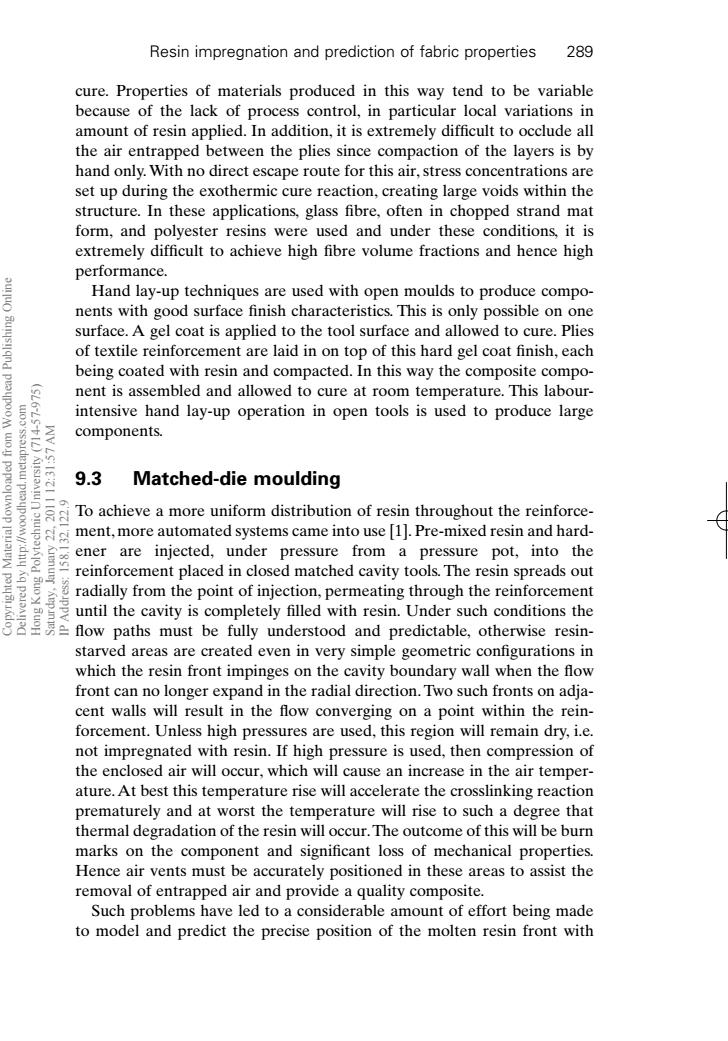正在加载图片...

Resin impregnation and prediction of fabric properties 289 cure.Properties of materials produced in this way tend to be variable because of the lack of process control,in particular local variations in amount of resin applied.In addition,it is extremely difficult to occlude all the air entrapped between the plies since compaction of the layers is by hand only.With no direct escape route for this air,stress concentrations are set up during the exothermic cure reaction,creating large voids within the structure.In these applications,glass fibre,often in chopped strand mat form,and polyester resins were used and under these conditions,it is extremely difficult to achieve high fibre volume fractions and hence high performance. Hand lay-up techniques are used with open moulds to produce compo- nents with good surface finish characteristics.This is only possible on one surface.A gel coat is applied to the tool surface and allowed to cure.Plies of textile reinforcement are laid in on top of this hard gel coat finish,each being coated with resin and compacted.In this way the composite compo- nent is assembled and allowed to cure at room temperature.This labour- intensive hand lay-up operation in open tools is used to produce large 2 components. 9.3 Matched-die moulding To achieve a more uniform distribution of resin throughout the reinforce- oo/ ment,more automated systems came into use [1].Pre-mixed resin and hard- ener are injected,under pressure from a pressure pot,into the reinforcement placed in closed matched cavity tools.The resin spreads out 豆 radially from the point of injection,permeating through the reinforcement until the cavity is completely filled with resin.Under such conditions the 8 flow paths must be fully understood and predictable,otherwise resin- starved areas are created even in very simple geometric configurations in which the resin front impinges on the cavity boundary wall when the flow front can no longer expand in the radial direction.Two such fronts on adja- cent walls will result in the flow converging on a point within the rein- forcement.Unless high pressures are used,this region will remain dry,i.e. not impregnated with resin.If high pressure is used,then compression of the enclosed air will occur,which will cause an increase in the air temper- ature.At best this temperature rise will accelerate the crosslinking reaction prematurely and at worst the temperature will rise to such a degree that thermal degradation of the resin will occur.The outcome of this will be burn marks on the component and significant loss of mechanical properties. Hence air vents must be accurately positioned in these areas to assist the removal of entrapped air and provide a quality composite. Such problems have led to a considerable amount of effort being made to model and predict the precise position of the molten resin front withcure. Properties of materials produced in this way tend to be variable because of the lack of process control, in particular local variations in amount of resin applied. In addition, it is extremely difficult to occlude all the air entrapped between the plies since compaction of the layers is by hand only. With no direct escape route for this air, stress concentrations are set up during the exothermic cure reaction, creating large voids within the structure. In these applications, glass fibre, often in chopped strand mat form, and polyester resins were used and under these conditions, it is extremely difficult to achieve high fibre volume fractions and hence high performance. Hand lay-up techniques are used with open moulds to produce components with good surface finish characteristics. This is only possible on one surface. A gel coat is applied to the tool surface and allowed to cure. Plies of textile reinforcement are laid in on top of this hard gel coat finish, each being coated with resin and compacted. In this way the composite component is assembled and allowed to cure at room temperature. This labourintensive hand lay-up operation in open tools is used to produce large components. 9.3 Matched-die moulding To achieve a more uniform distribution of resin throughout the reinforcement, more automated systems came into use [1]. Pre-mixed resin and hardener are injected, under pressure from a pressure pot, into the reinforcement placed in closed matched cavity tools. The resin spreads out radially from the point of injection, permeating through the reinforcement until the cavity is completely filled with resin. Under such conditions the flow paths must be fully understood and predictable, otherwise resinstarved areas are created even in very simple geometric configurations in which the resin front impinges on the cavity boundary wall when the flow front can no longer expand in the radial direction. Two such fronts on adjacent walls will result in the flow converging on a point within the reinforcement. Unless high pressures are used, this region will remain dry, i.e. not impregnated with resin. If high pressure is used, then compression of the enclosed air will occur, which will cause an increase in the air temperature. At best this temperature rise will accelerate the crosslinking reaction prematurely and at worst the temperature will rise to such a degree that thermal degradation of the resin will occur.The outcome of this will be burn marks on the component and significant loss of mechanical properties. Hence air vents must be accurately positioned in these areas to assist the removal of entrapped air and provide a quality composite. Such problems have led to a considerable amount of effort being made to model and predict the precise position of the molten resin front with Resin impregnation and prediction of fabric properties 289 RIC9 7/10/99 8:32 PM Page 289 Copyrighted Material downloaded from Woodhead Publishing Online Delivered by http://woodhead.metapress.com Hong Kong Polytechnic University (714-57-975) Saturday, January 22, 2011 12:31:57 AM IP Address: 158.132.122.9